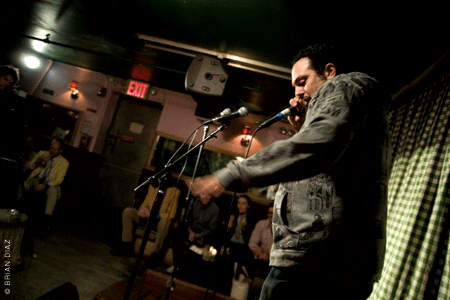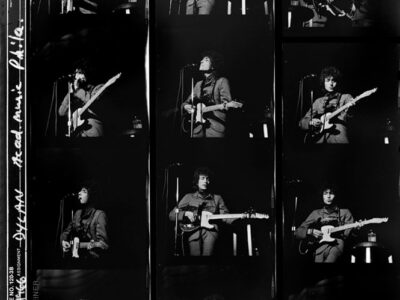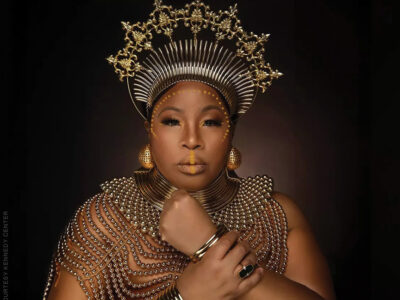
After thanking the standing-room-only crowd at the Brooklyn Academy of Music on an unseasonably cool June evening this summer, Adam Matta EAS’96 held the mic close to his lips. The audience at New York City’s first Muslim Arts Festival waited.
Then Matta started beatboxing (defined by one source as “a form of vocal percussion which primarily involves the art of producing drum beats, rhythm, and musical sounds using one’s mouth, lips, tongue, voice and more”). Sounds emerged from him that resembled, alternately, actual instruments, voices, and machines—sputters, taps, pings, trumpets—all to a contagious, self-propelled beat. As if in choreographed synchronicity, listeners turned to their friends and companions with the raised eyebrow that translates to: How does he do that?
By having taught himself, it turns out.
“Pretty much everything I do is self-taught,” Matta says, “especially the sounds for which I am known, which include jazzier sounds, like an acoustic snare-drum sound, trumpet, and drum ’n’ bass-influenced rhythms.”
It’s clear that Matta has intellectualized his art.
“Beatboxing may be a continuation of the evolution of art forms, from painting to modernism to conceptual art to contemporary art, including installation and sound art,” he says in an email. “For instance, beatboxing is fundamentally mimetic. Like painters representing ‘real’ objects, subjects or motifs, we are making sonic references to sounds that one may identify as ‘real,’ i.e., the crack of a drum, the throb of a bass line, or the scratching of a turntable.”
While Matta beatboxed in high school and at Penn, he’s the first to admit that, at that point in his life, he “never thought of it as a potential art form, let alone career path.”
“Beatboxing was always falling out of my mouth when I wasn’t looking,” he says. “It was more like a nervous habit, the way some people tap their foot, hum, or whistle.”
Then in 1997, a year after he graduated from Penn, a friend overheard him beatboxing to himself and started telling people about it.
“I decided then that I would try and perform it publicly and see what the response would be,” Matta recounts. The response was remarkably positive. Matta started doing open-mic nights in 2000, and then started creating his own performances with friends. He became increasingly involved in the beatbox and downtown music scene in New York, performing at venues ranging from Prospect Park and the New Museum to Joe’s Pub. His schedule now includes events as diverse as the Oregon Shakespeare Festival and Salzburg’s International Opera Festival, as well as international beatboxing competitions.
“The international scene is awesome,” Matta says. “There is so much camaraderie, passion, and dedication to the art form. It’s a little insane. It’s about 150 people from all over the world, convening, jamming 24/7 in the streets or in the hostel hallways, and sharing sounds and techniques … but only up to a point, you don’t want to give too much away!”
Matta’s performing schedule teems over with events, both his own and as the opening act for groups like Kronos Quartet. Beatboxing is a world unto itself, with zealous, even messianic adherents—the “Staten Island of hip-hop,” as Matta puts it.
“A lot of beatboxers feel that beatboxing should be recognized as the fifth element of hip hop, after DJ-ing, MC-ing, graff, and b-boying,” he explains. “I was thinking about that, and how there are five boroughs in New York, where hip hop and beatboxing originated. I started to think that if you mapped the five elements against the five boroughs, beatboxing would most likely come up as Staten Island, since it’s typically the ‘forgotten borough.’”
Although Matta does give lessons, there’s no school for beatboxing per se, except for learning from one’s peers.
“I have picked up a few ideas from other beatboxers,” he says. “I’ve also learned a great deal just by doing it for many years, having to back up other musicians, and support them appropriately. Your time and clarity improve when you perform with musicians who are more experienced than you. Also, just jamming with others has given me more and more ideas and directions to keep working on—if I come up with a new sound in a jam, I try and make a mental note and/or record it.”
Matta also learns from his collaborators—musicians, spoken-word artists, and singers. He was an artist-in-residence at Cornell for two years.
“I would create two live shows a month, where I brought in different musicians to jam with me each time, and we would invite the students to jam with us as well,” says Matta. Among the artists he brought in were cellist Hank Roberts, violinist Julianne Carney, beatboxer Masai Electro, singer-songwriter Sparlha Swa, and avant-garde guitarist Eyal Maoz.
Matta also created a large music festival at Cornell celebrating Middle Eastern and Jewish music with an “urban edge,” such as Pharaoh’s Daughter and Haale. At the Brooklyn Academy of Music he beatboxed with a Turkish opera singer, an Israeli guitarist, a Palestinian poet, internationally known beatboxer Kenny Muhammad, and a vocalist trained in the North Indian classical tradition. At one point, Matta’s father, Seoud Matta, performed a classical Egyptian song, with Matta beatboxing backup.
Along with the cultural fusion, Matta—who is also a painter—pushes the envelope of beatboxing through the integration of visual and aural art. He is hoping to learn the programming language Max/MSP, which installation artists and composers use to link video and audio, and to trigger and manipulate visual and audio material.
One of Matta’s performance-art pieces is called “Bicycle Drawing,” where he does mountain-bike tricks on canvas with paint on the tires, and leaves a painting behind. “Sometimes I’ll beatbox and loop it, and do the performance to the beat, or sometimes I’ll actually try and do both simultaneously,” he says. “There are some synergies between sound and visual art that Kandinsky started to write about in some of his books.
“The beats that a beatboxer pieces together are like the scraps of paper and found objects assembled by a collage artist,” he adds. “Beats and sounds are juxtaposed like the lines, shapes and colors of a painting.”
—Jordana Horn C’95 L’99




